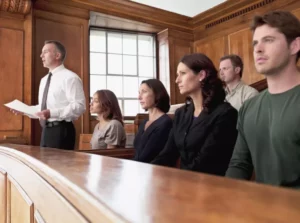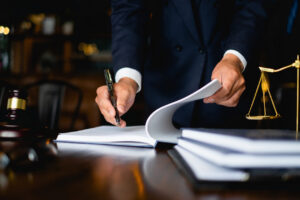
People who sustain injuries in accidents can secure compensation from the individual or individuals at fault in a civil lawsuit. The burden of proof is an essential component of any personal injury lawsuit.
Claimants must satisfy the burden of proof. They must convince the trier of fact that there is enough evidence to support their claim.
If they meet the burden of proof and establish liability, they can receive an award for damages. Damages compensate for the harm they suffered in the accident due to another person’s careless choices.
What Is the Burden of Proof?

Since personal injury accident victims must do the work of showing that the person who harmed them was negligent, they bear the burden of proof. It is their responsibility to present evidence that supports their claim.
In a legal context, the party with the burden of proof must present evidence that establishes a legal theory.
In a criminal case, the state prosecutors bear the burden of proving that a defendant is guilty. Civil cases generally place this burden on the plaintiff asserting an injury.
The Standard of Proof
The standard of proof expresses the amount of evidence needed to prove a claim.
A plaintiff in a personal injury case must present evidence sufficient to meet the standard of proof.
There are several different standards of proof. They vary in the degree of certainty required. Some standards of proof require less evidence, while others demand conclusive proof.
In most injury cases in Florida, the standard of proof is the preponderance of the evidence standard.
The Preponderance of the Evidence Standard
Satisfying the preponderance of the evidence standard requires a victim to show that it is more likely than not that the alleged wrongdoer is at fault.
The victim is the plaintiff asserting the case and bearing the burden of proof. The alleged wrongdoer is the defendant responding to the case.
The defendant’s attorney will attempt to cast doubt on the plaintiff’s evidence. Or, the defendant’s attorney may assert that the plaintiff does not have enough evidence to show that the defendant is more likely than not at fault for the accident.
If the defendant is found liable, the defendant must pay the plaintiff. Civil charges will not result in a criminal sentence. So, jurors do not have to be completely sure as long as they think it is more likely than not that the defendant bears liability.
Clear and Convincing Evidence
Some civil case contexts in Florida require a plaintiff to establish clear and convincing evidence of the defendant’s conduct. For instance, in personal injury cases, the standard for a victim to receive punitive damages is clear and convincing evidence.
A victim can recover compensatory damages by showing that the defendant was more likely than not at fault. Yet if the victim seeks punitive damages, an additional payment that punishes the defendant for particularly egregious conduct, a higher standard of clear and convincing evidence is required.
Clear and convincing evidence is an intermediate standard between a preponderance of the evidence and beyond a reasonable doubt.
Beyond a Reasonable Doubt
The beyond-a-reasonable-doubt standard is not typically used in civil cases. Instead, this is the standard for criminal cases. This standard is very high because the defendant’s liberty is at stake.
Injury victims likely will not need to show that the alleged wrongdoer is guilty beyond a reasonable doubt.
Negligence
Underlying most personal injury claims is the theory of negligence. Injury victims must establish that the person, people, or entity responsible for their accident was negligent.
Per Florida law, a “negligence action” means a civil action for damages based upon a theory of negligence, strict liability, product liability, professional malpractice, or breach of warranty.
Four elements comprise a standard negligence claim:
- Duty -- There was a duty to exercise reasonable care.
- Breach -- The individual breached their duty of care.
- Harm -- The victim sustained harm, such as a bodily injury.
- Causation -- The individual’s actions caused the harm.
Suppose a drunk driver runs a red light, crashing into another car. The driver of the struck car sustains severe injuries as a result.
In this example, the injured driver could sue the drunk driver for negligence. A successful claim would require the litigant to establish all four elements of negligence.
The victim would have to bring evidence showing the following:
- The drunk driver owed the injured driver a duty to exercise reasonable care. Drivers must drive reasonably, following the rules of the road and laws prohibiting driving under the influence.
- When the driver drove drunk and violated the rules of the road by running a red light, the driver breached the driver’s duty to exercise reasonable care.
- During the car accident, the victim sustained severe injuries.
- The driver’s actions caused the injuries.
The victim would need to provide enough evidence to satisfy each of these elements by a preponderance of the evidence. As noted above, clear and convincing evidence of egregious conduct becomes the standard if punitive damages are sought.
The drunk driver will likely face criminal charges. Yet a criminal conviction would not require the driver to pay the victim.
In addition to pursuing an insurance claim, the victim can make take legal action to pursue compensation. This requires the victim to bring the case to court and prove negligence.
Contact a Qualified St. Petersburg Personal Injury Lawyer
If you have been injured in a St. Petersburg, Florida, personal injury accident, it may be in your best interest to hire an attorney. Should you obtain representation, your lawyer can help you gather and obtain the evidence necessary to meet the burden of proof in your case.
Since most lawyers in this area of the law offer free consultations, you can reach out at (727) 933-0015 at Lopez Accident Injury Attorneys for legal advice at no cost. In addition, under the contingency fee payment structure, your St. Petersburg personal injury attorney only gets paid if you do.